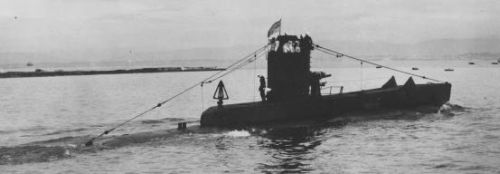- Author
- Selby, Gordon
- Subjects
- Biographies and personal histories, WWII operations
- Tags
-
- RAN Ships
- None noted.
- Publication
- December 2002 edition of the Naval Historical Review (all rights reserved)
ON 1ST JULY 1941 Lieutenant Wanklyn received his promotion to Lieutenant Commander and the Malta based submarines became the 10th Submarine Flotilla. At about the same time I was rated Acting Petty Officer and backdated several months. In August, two SAS soldiers were landed on the Sicilian coast in an unsuccessful attempt to demolish a section of the railway which ran close to the coast and, during the same patrol, two 6000 ton ships were sunk as well as two hits being scored on the Italian cruiser Garibaldi travelling at 28 knots at the time.
In September we sailed on the 16th in company with Ursula, Unbeaten and Upright to intercept a troop convoy known to be on its way to Tripoli. A sighting report was received from Unbeaten in the deep field during the early hours of the 18th and the three ships, together with half a dozen destroyers, appeared at about 0400. A heavy sea was running at the time and Upholder’s gyrocompass had failed, so the helmsman was having an extremely difficult time trying to hold the submarine to anything like the required course. In these circumstances Lieutenant Commander Wanklyn decided to carry out a surface attack and to fire his torpedoes by eye, using the yawing of the submarine to spread the salvo over the targets. Three hits were obtained, resulting in the sinking of the 19,500 ton Oceania and sufficient damage to the screws of Neptunia, of similar size, to bring her to a standstill. Upholder was then dived and taken deep, to permit the reloading of her torpedo tubes. When it returned to periscope depth some two hours later it was daylight and the submarine was forced deep again by a destroyer. The CO then decided to pass underneath the damaged Neptunia and finish it off with two torpedoes from the other side. Those torpedoes struck just at the time that Unbeaten, who had followed up the track of the convoy, was about to fire from the opposite side and Neptunia quickly joined Oceania on the bottom. Vulcania, the third ship of the convoy, took off at high speed and survived. In the event the escorting destroyers were kept so busy picking up survivors that no depth charge attack was made. Upholder was back in harbour four days after sailing.
Just after dawn on 8th November an Italian submarine of the PERLA class was sunk, and the following night we had a grandstand view of Force K, consisting of the cruisers Penelope and Aurora together with two destroyers, demolishing a complete convoy. Towards the end of that action Upholder closed the scene and sank the Italian destroyer Libeccio, whilst later on the same morning, another destroyer was damaged.
On 5th January 1942 the Italian submarine Ammiraglio St. Bon was sighted on the surface just before dawn and sunk with the only torpedo remaining after three previous attacks on surface ships. Three survivors were picked up from this sinking and taken to Malta. There followed one further patrol in January, this time off Taranto in company with other submarines, to intercept any of the Italian fleet which might sail to attack a convoy being forced through to Malta.
In June 1941 Fleigerkorps II, previously based in Sicily, had been transferred to the Russian Front with the resultant easing of air attacks on Malta, but the chaos being created by the 10th Flotilla on Rommel’s supply lines to North Africa led to the Fleigerkorps being returned to Sicily in December 1941 and special attention given by it to the Lazaretto base. As a result, during the first four months of 1942 five submarines were damaged in harbour by air attack, two beyond repair, and two more sunk; this in addition to P.38 being lost on patrol.

Upholder sailed for its twenty second patrol early in February 1942 under the command of the spare CO, Lieutenant C.P. Norman, and shortly after its return to harbour, Lieutenant Commander Wanklyn asked me if I would agree to a transfer to a newly arrived submarine P.39 as its coxswain on the understanding that I would immediately be rated Acting CPO and would stay with that boat for not more than six months. Knowing that Upholder would be due to return to the UK for refit within the next few weeks, this provided me with a difficult decision to make but, after a couple of days thought, I accepted the opportunity for quick promotion and joined P.39 on 15th February. Little did I know at the time that this decision was to save my life because, whilst on its final patrol before sailing for the UK, Upholder was sunk with all hands off Tripoli on 14th April 1942. The Italian torpedo boat Pegaso was credited with its sinking by depth charging.




